The AMD A8-7650K APU Review, Also New Testing Methodology
by Ian Cutress on May 12, 2015 10:00 AM ESTProfessional Performance: Windows
Agisoft Photoscan – 2D to 3D Image Manipulation: link
Agisoft Photoscan creates 3D models from 2D images, a process which is very computationally expensive. The algorithm is split into four distinct phases, and different phases of the model reconstruction require either fast memory, fast IPC, more cores, or even OpenCL compute devices to hand. Agisoft supplied us with a special version of the software to script the process, where we take 50 images of a stately home and convert it into a medium quality model. This benchmark typically takes around 15-20 minutes on a high end PC on the CPU alone, with GPUs reducing the time.
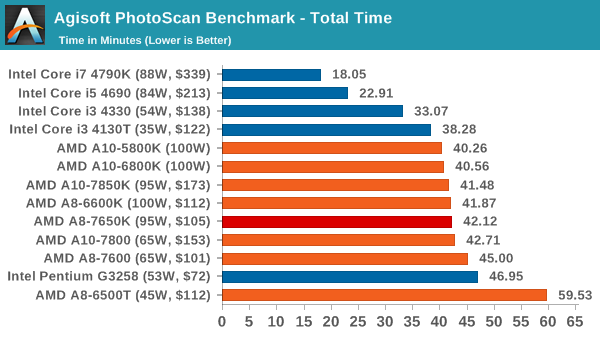
Photoscan prefers full threads and high IPC, so the low end i3, AMDs APUs and the G3258 all perform within a similar margin.
Cinebench R15
Cinebench is a benchmark based around Cinema 4D, and is fairly well known among enthusiasts for stressing the CPU for a provided workload. Results are given as a score, where higher is better.
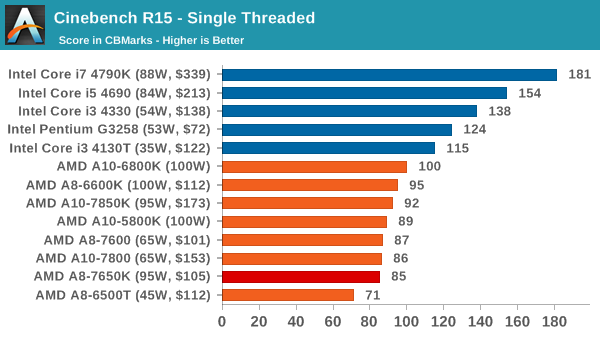
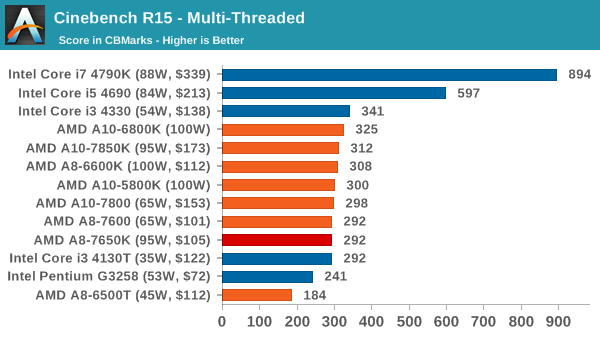
Despite the single thread performance, in multithreaded the gap between Pentium, i3-T, APU and i3 is similar to that seen in Photoscan.
HandBrake v0.9.9: link
For HandBrake, we take two videos (a 2h20 640x266 DVD rip and a 10min double UHD 3840x4320 animation short) and convert them to x264 format in an MP4 container. Results are given in terms of the frames per second processed, and HandBrake uses as many threads as possible.
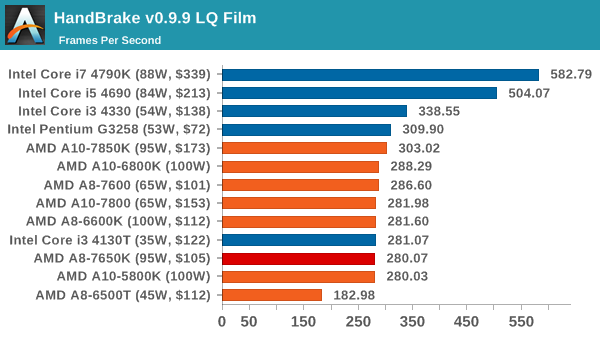
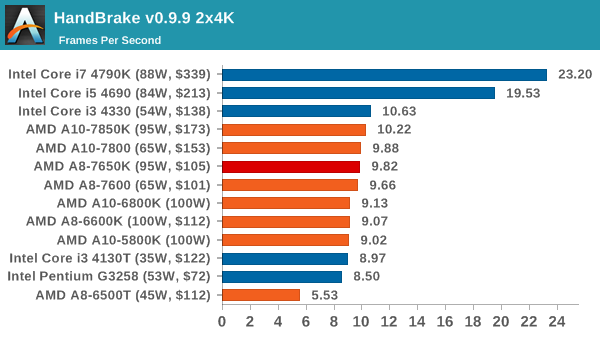
It's a similar story here, especially when we bring up 4K encoding in Handbrake. The APUs outperform the G3258 and the more expensive i3-T, but the i3-4330 is marginally quicker.
Hybrid x265
Hybrid is a new benchmark, where we take a 4K 1500 frame video and convert it into an x265 format without audio. Results are given in frames per second.
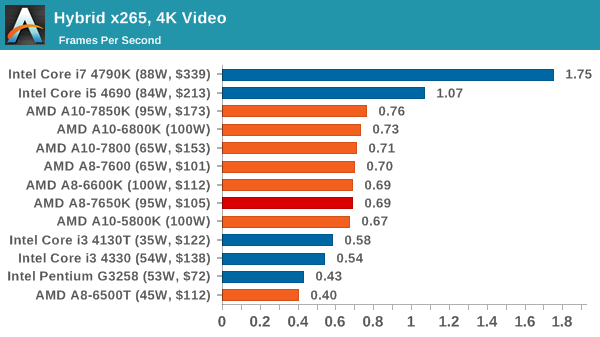










177 Comments
View All Comments
Michael Bay - Wednesday, May 13, 2015 - link
If this abomination is all about mobile applications, no wonder one has to search with a flashlight for an hour to find a notebook on AMD, and then it`s some 15 inch tn+ crap.And in daily use it`s extremely easy to spot a difference, since systems on AMD will always have wailing CO.
jabber - Wednesday, May 13, 2015 - link
Yep the OEMs just don't want or need AMD anymore.Pissedoffyouth - Tuesday, May 12, 2015 - link
Works great for extremely micro buildsharrkev - Tuesday, May 12, 2015 - link
Ummm. Not quite. For desktop, the APU concept might be mostly irrelevant unless on a tight budget. For laptop people (like me), the APU is everything. To get a discrete graphics chip, you are generally looking at north of $1000. If your laptop budget is around $500 or so and you want to play the occasional game, the APU matters. An AMD processor will game circles around and Intel chip if using built-in graphics.My dream machine right now is a laptop with a high-end Carrizo and a displayPort to drive big monitors.
jabber - Tuesday, May 12, 2015 - link
Just a shame you'll never see one in the stores!LogOver - Tuesday, May 12, 2015 - link
AMD integrated graphics is better than Intel's... but only if we're talking about desktop offerings with 95W TDP. AMD mobile offering (low power apus with "good enough" graphics) is pretty much non existent.TheinsanegamerN - Wednesday, May 13, 2015 - link
coming from someone who had an AMD APU notebook, no. AMD's graphics are nowhere near as nice in mobile, where the low TDP hammers them. When it comes to games, intel's hd 4600 ran circles around the a10-4600m and the a10-5750m. framerates were not only higher, but much more consistent. AMD's kaveri chips were 15 watt, and still couldnt match 15 watt intel chips.geekfool - Tuesday, May 12, 2015 - link
Did you look into why i3-4130T ended up faster in x265 than i3-4330? The latter is strictly faster and there is no turbo that could difference things due to individual chip quality. I suspect some of those results must be wrong, which sorta casts shadow onto all of them.(I hope you didn't mix different x265 versions, because the encoder is continually being optimised and thus newer versions do more work per MHz than older ones? You don't ever say what parameters/data the the tests use, so it is hard to guess what went wrong).
rp1367 - Tuesday, May 12, 2015 - link
It seems you have a better idea in designing silicon than AMD. Why not make your own silicon so that you will be impressed by your pwn expectation? The APU is a revolutionary design and no silicon maker can match this on general purpose use from office to gaming.jeffry - Tuesday, May 12, 2015 - link
I think this PC setup is a good option. we all shop on budgets, i dont know anyone who does not. if more money comes in, say, 6-12 month later, i would just buy a dedicated GPU (~150 bucks) and thats it...